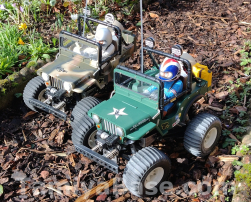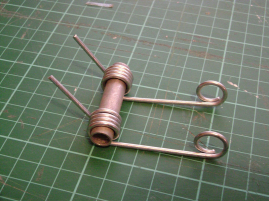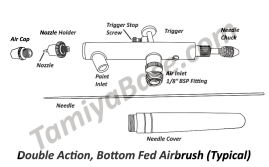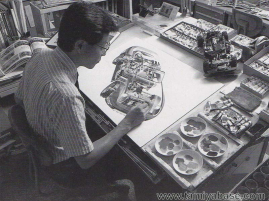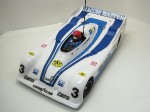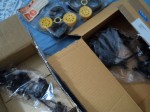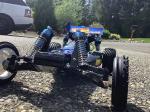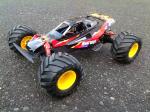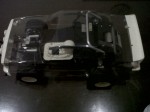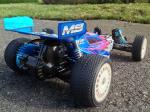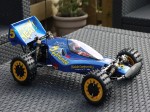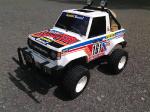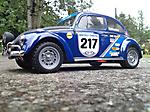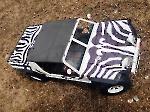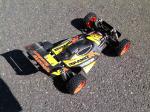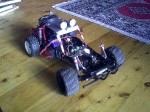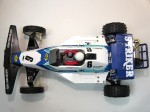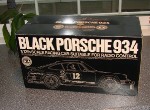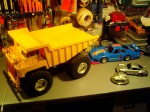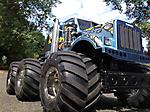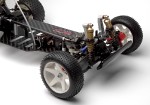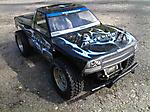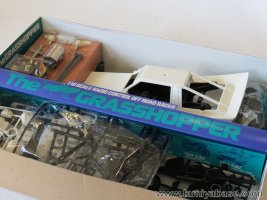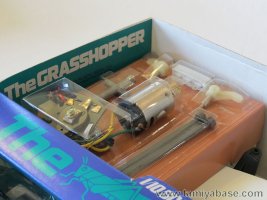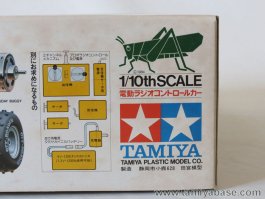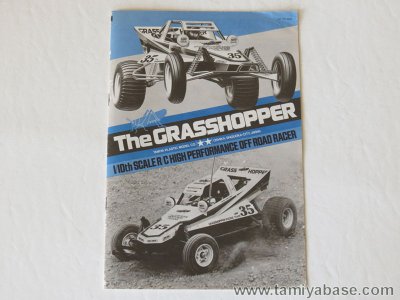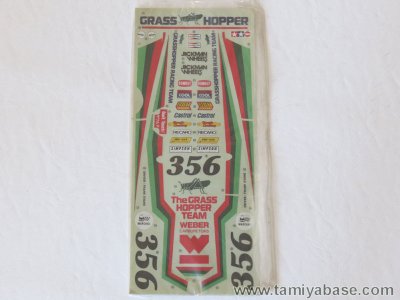Today it remains a must-have classic for collectors – a gorgeous scale off-roader that still looks amazing, and is one of those pieces of Tamiya history that really defined the brand. Ask the average person on the street to name some of the R/C cars released by Tamiya during the 1980s, and there’s a very good chance that “The Grasshopper” will be one of the names they remember.
It was undoubtedly one of Tamiya’s best-selling buggies of the era.
Remarkably, the unusual notion of naming radio controlled buggies after animals (which I also covered in my article about The Hornet) proved to be such an enormous hit for Tamiya that it became something of a defining moment in the brand’s R/C history.
To this day, the Tamiya brand remains synonymous with the 1980s R/C buggy “craze” in the minds of many people. But in particular, it conjures memories of a range of colourful, unique and character-driven off-road vehicles they released during those fertile years when the hobby was still young.
Tamiya’s success with kits like The Grasshopper established them as the dominant brand in the mainstream off-road R/C kit market. And it inspired countless copies from other brands, who viewed the popularity of cars like the Grasshopper and Hornet as an opportunity to create similar R/C toys.
As the decades passed and nostalgia for toys of the 1980s grew, this inevitably meant Tamiya began issuing updated versions of those past hits, trading on past glories, yet releasing few brand new models that could be said to carry the spirit of what made those originals great in the first place. (One wonders what Tamiya will have left to reissue 20 years from now?).
That’s not to say Tamiya don’t continue to make quality products. It’s just that the 1980s was such a unique time, when the R/C hobby was new and exciting. Each successive model felt fresh and different. There was still an emphasis on scale model realism, even in buggies. And the real world vehicles the toys were based on also seemed to lend themselves extremely well to miniaturization – with simple, attractive Baja bug and sand rail designs with modest suspension travel, and lots of bright, attractive colours and graphics. Unlike the gangly looking vehicles of today.
If you look at the R/C buggies Tamiya have released in the past 15 years or so, many now feel like “by-the-numbers” designs that not only lack realism, but also individuality. Perhaps there’s no new design territory left to explore within the performance demands of modern R/C? Yet even many of the names seem to lack imagination – about 7 new Tamiya buggies in the past decade or so have been called “…Fighter” or “Fighting…”. Tamiya have been phoning-in their buggy ideas for years.
But it wasn’t always so.
Back in 1984, the hobby was young and really taking off. And the Grasshopper not only represented the perfect new product (an easy to build, tough, off-road buggy) at the perfect moment. It was also a perfect synthesis of marketing ideas, and had a nice combination of design, name, and colours that would prove appealing to a wide audience.
First released in May 1984, here it is on the cover of the 1984 Tamiya R/C Guide Book…
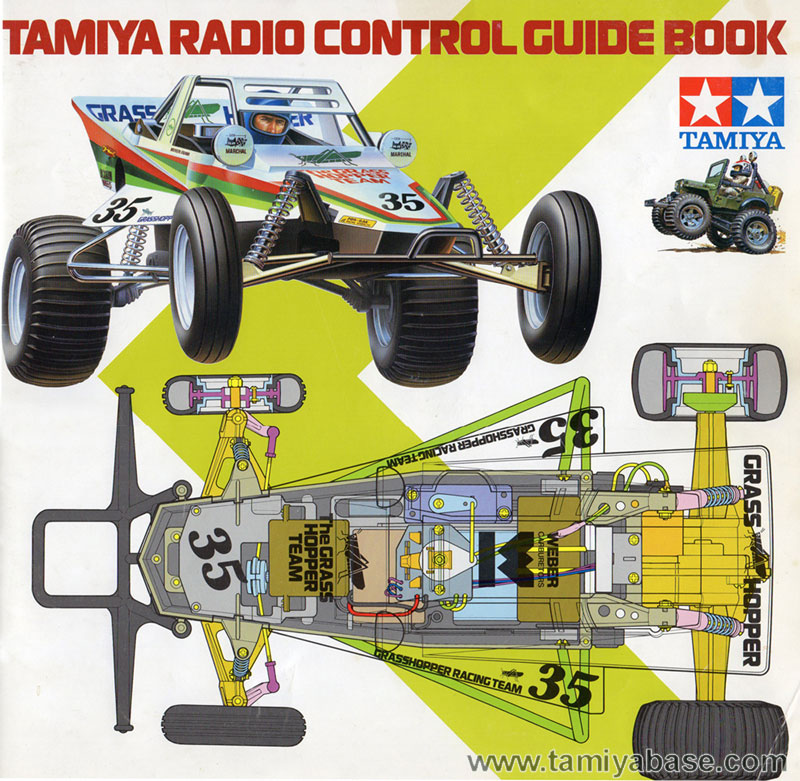
And here’s the official catalogue image of the Grasshopper as well…
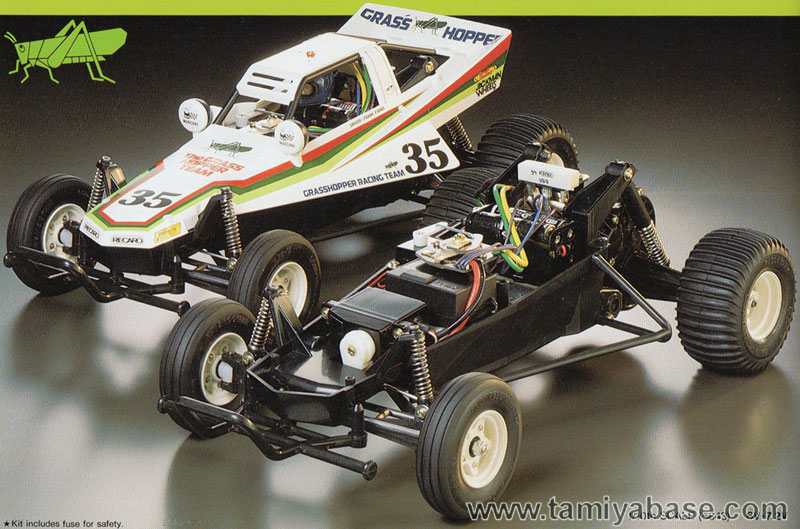
These official action shots also appear in some of the old catalogues…
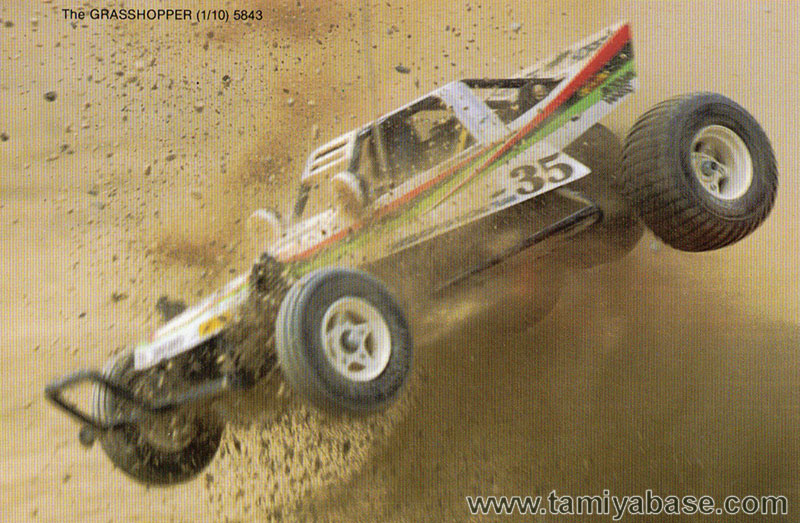
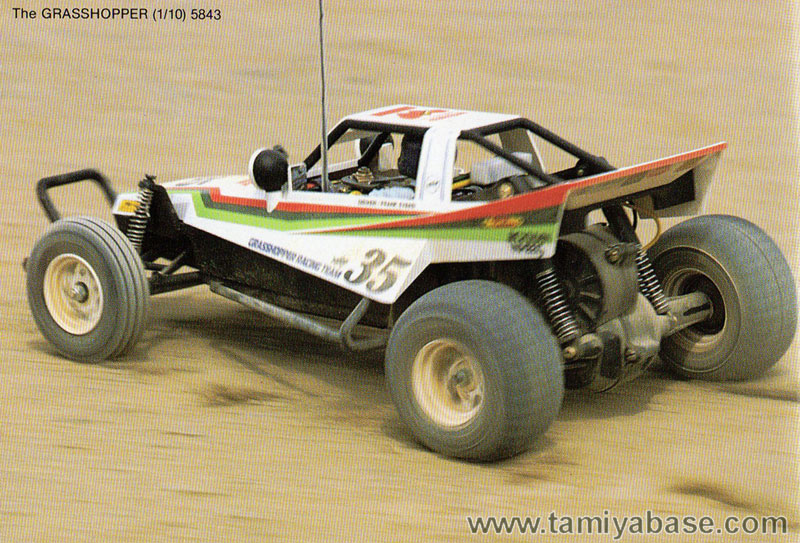
Based on the popular single seat off-road racers seen in events like the Baja 1000, the Grasshopper was a toy that continued Tamiya’s devotion to scale realism as well as being fun and versatile.
And with its bright green (grass-like) striping and angular body, there can be no denying that they somehow managed to blend the world of full scale buggy racing, with a sort of familiar ‘natural’ aesthetic.
Take a look at that little green ‘Grasshopper’ logo in the top left of the catalogue pic above. The side profile of that cartoon grasshopper insect matches the side profile of the body design in Tamiya’s model quite closely. The high rear spoiler (abdomen), slanting rollbars (lower rear legs), front suspension and bumper (front legs)…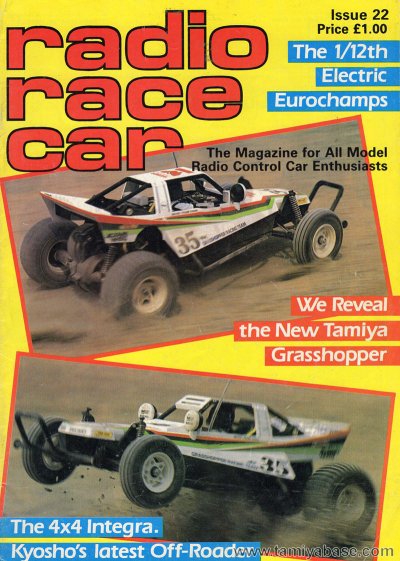
The overall effect is of something that’s familiar, yet fresh, and that “just looks right” as a scale model toy. You might even say that the car’s relationship to the shape of the animal, echoes how we respond to the things like the Volkswagen Beetle. After all, ‘the Beetle’ was inspired by real beetles – the bonnet and boot resembling folded insect wings. Sometimes a industrial design’s link to the natural world can result in an evergreen shape that human eyes will appreciate for many years. Perhaps at some level, we actually crave seeing the natural in the unnatural. Think about how people often view car headlights as being like “eyes”.
And it’s no wonder children were sent into a spin for reasons they could barely understand, falling in love with the idea of Tamiya’s range of buggies with their unique and memorable names and colours.
Many of the kids I knew were actually convinced that both the Tamiya Frog and the Tamiya Grasshopper were “better at jumping” than other buggies on the market, and I’ve even heard someone (now in his late 30s) make that same claim to me in only the past year.
Tamiya’s masterful, narrated promo videos were also a perfect way to get kids attention in hobby stores…
Featured here is a still unbuilt, brand new original Grasshopper kit from 1984…
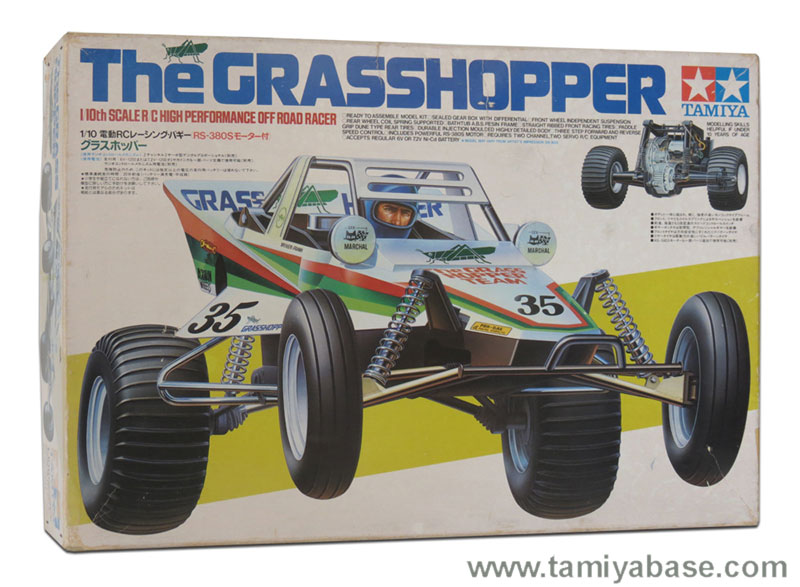
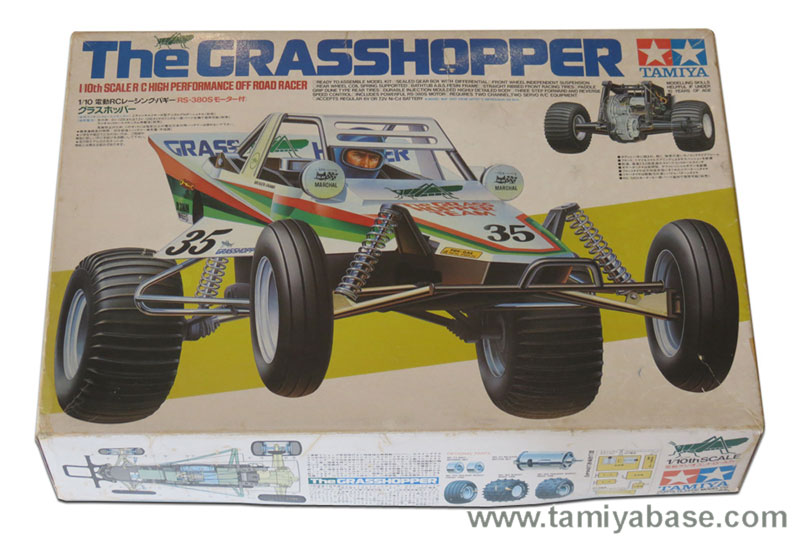
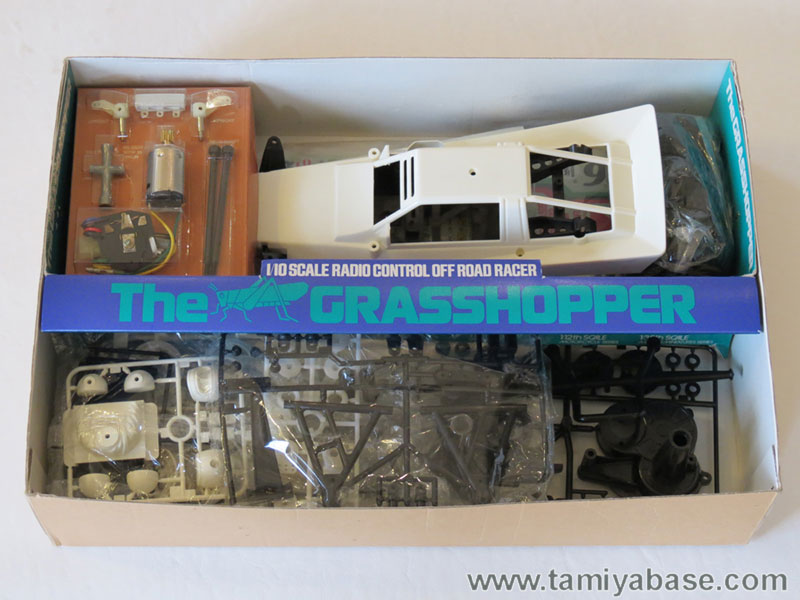
Tamiya’s pioneering box art imagery also played a significant role in the success of their models, and the Grasshopper artwork of course features the car leaping (hopping?) toward you, but in the opposite direction to that of the Tamiya Frog box (which tended to make the boxes look rather great sitting side-by-side on a hobby store shelf!).
Inside the kit box, the Grasshopper looks neat and enticing when you first open it up. But as it was intended to be Tamiya’s entry level offering, it’s not too daunting either. There’s just one blister pack of special sealed parts and the rest is comprised of the chassis, body, tyres, smaller packets and parts trees.
The car is powered by a Mabuchi 380 motor, which is slower than the Mabuchi 540 motor found in most Tamiya models. 380 motors were still popular in kit-based R/C models in the early 1980s for their reasonable speed and longer run times on a single battery charge. In effect, the Grasshopper filled the vacant slot left in Tamiya’s line-up as they phased out two other 380 motor powered buggies, namely the Sand Rover and Holiday Buggy.
The Grasshopper kit also experienced some slight changes during its production run. Initially the kit came standard with a mechanical speed control fitted with a plug that would only connect to the smaller 6volt (5 cell) battery packs. As the 1980s progressed, 7.2 volt (6 cell) batteries became the common type, and I believe later Grasshopper kits began to include mechanical speed controls to suit these batteries. All Grasshoppers have enough space in their battery cavity to hold a 6volt, 7.2volt and even a 7.2volt ‘hump pack’ battery.
Now let’s take a look at a new-built example.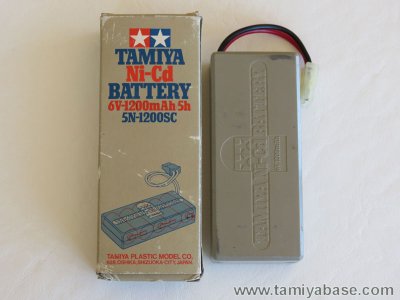
As with all my kit builds, this one is finished as per the standards of a fussy collector and die-hard box-art fanatic. Growing up, I knew that if I was ever lucky enough to own some Tamiya kits, I’d be building them exactly as standard spec, as to me this is what they were meant to be.
So this one is absolutely original-spec (no upgrades) right down to the screws, the mechanical speed controller, and the black plastic bearings. I built this one from an original kit, and tried to keep it as close as possible to the look of the example featured in the Tamiya catalogue images, in terms of decal placement and driver colour. It even has the 6volt mechanical speed control on board.
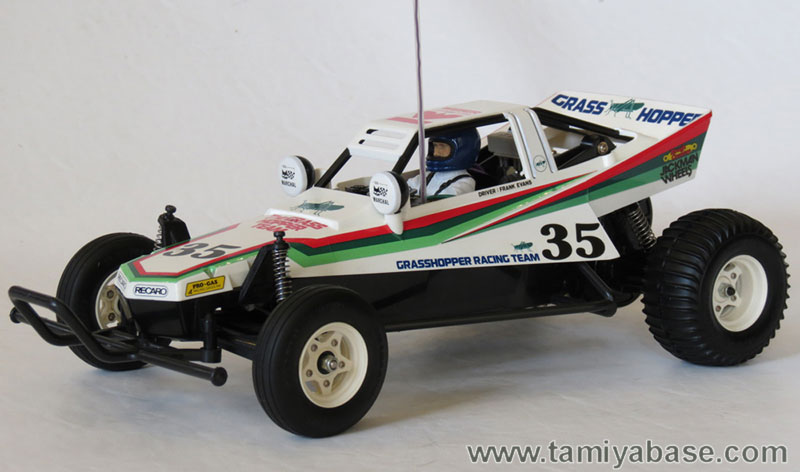
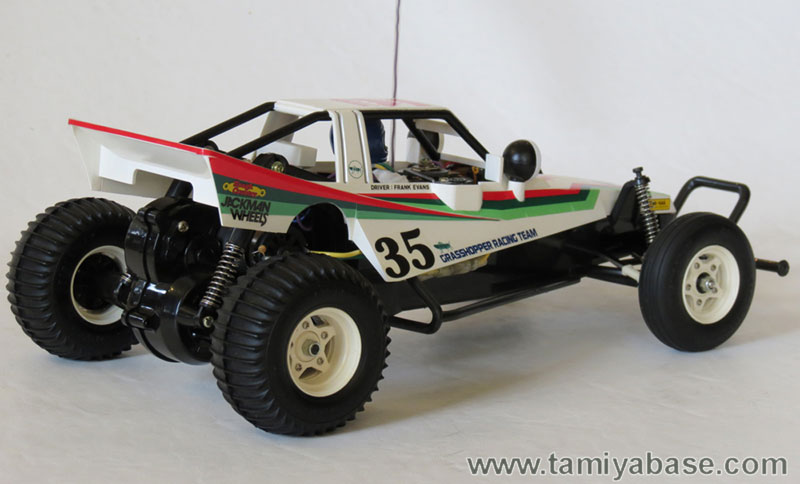
At the time of it’s release, the Grasshopper’s bathtub type chassis was still a reasonably new configuration on the market. It’s a simple, yet strong design, which also offers easy access to your radio equipment. And when coupled with a sealed rear axle gearbox with differential, independent front suspension, and rolling rigid rear axle suspension – you have an overall configuration that has arguably been the most common R/C buggy design in history. After all, nearly every single ready-to-run 2WD R/C buggy manufactured by brands like Nikko, Taiyo and a myriad of others, was a copy of this basic configuration by Tamiya. And many of them are still following it to this day (over 30 years later).
The Grasshopper’s body is an injection molded type, and is pretty tough – but perhaps not as tough as a polycarbonate body during impacts. I have seen a few examples over the years with broken rear wings. Still, it afforded the benefit of more realistic details such as the black rear roll bars, and as with all hard resin body shells it’s very satisfying to paint and do all the little details on it. Just take your time, mask things off carefully, and spray.
One unusual aspect of the Grasshopper is the fact that the body affixes to the car with 4 screws, rather than the body pins found on most R/C models. While this does prove to be a hassle when you need to remove the body, it also leaves Grasshopper’s body free of those pins and therefore looking a bit more realistic.
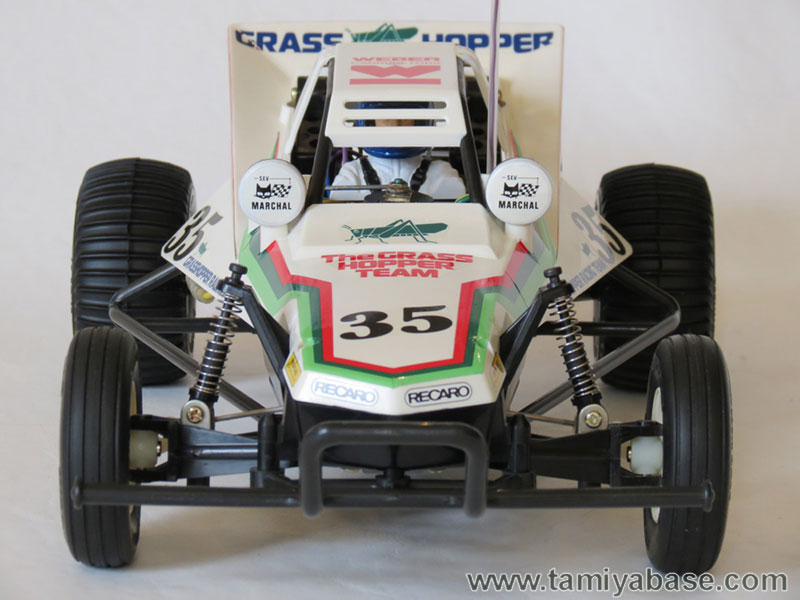
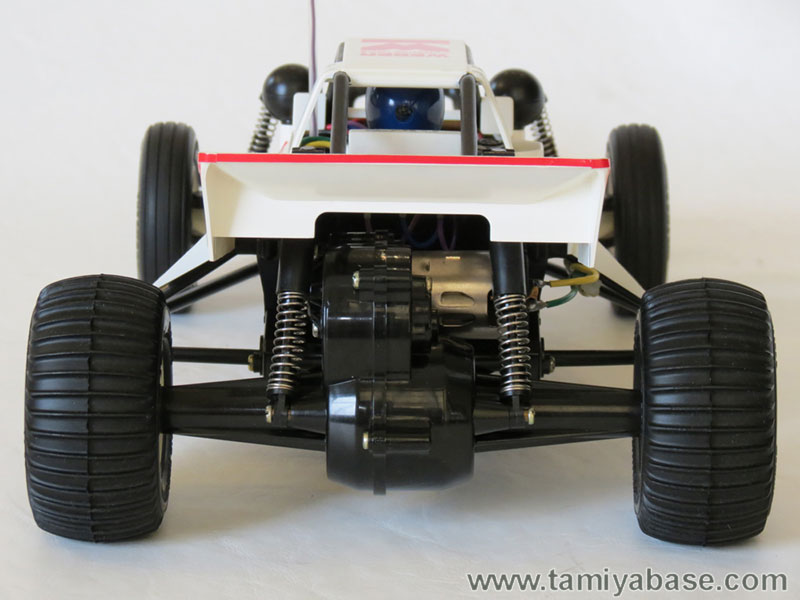
In keeping with Tamiya’s clever marketing, the Grasshopper’s decals are a mix of simple stripes and logos within a limited colour palette. Of course it had to be primarily green on white – but there’s a flourish of red and blue throughout as well. But notice that it barely goes beyond those four colours – and even the box art sticks to the same palette.
I think colours can be an integral part of the both the design of an R/C car, but also it’s marketing. The association you get from a car called “The Grasshopper”, which looks a bit Grasshopper-like, uses a limited colour theme with lots of green, plus has a box image that shows it jumping… all played a part in making this product a success.
And let’s not forget that great little “Grasshopper” character logo that appears on the car in many places…
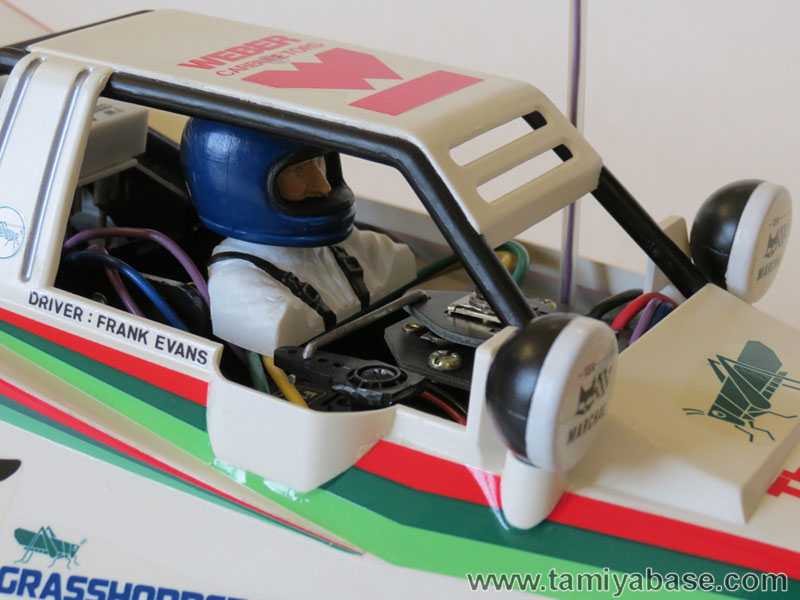
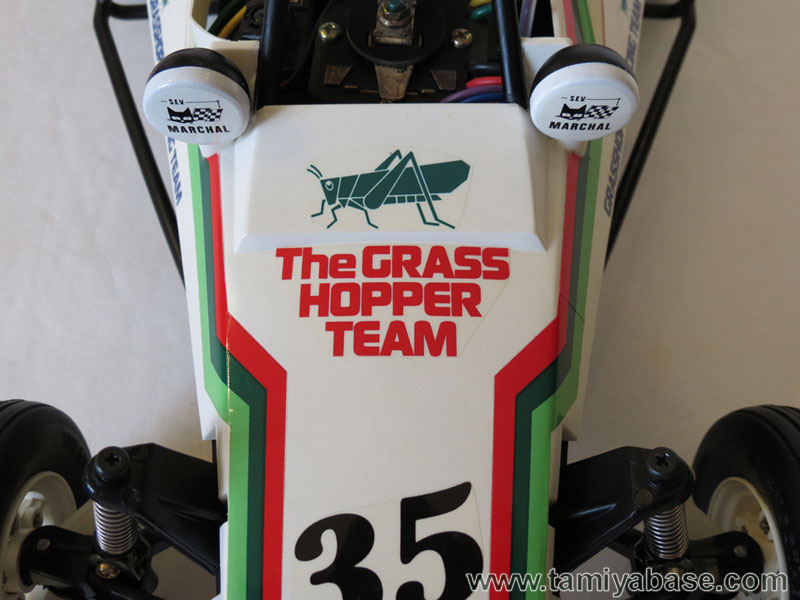
Elsewhere of course, the buggy carries many real world sponsor logos such as Recaro, Weber, Jackman Wheels and others.
This car was also the third Tamiya model (not directly based on a real-life racing car) to include a driver name decal, with “Frank Evans” on the decal sheet. Was Frank Evans actually a real person? Who knows. The first Tamiya buggy to have a driver name was the Super Champ with “Al Ernat”, and fans later discovered that the name was that of an employee at a hobby store in California. We also know that company director Shunsaku Tamiya originally visited California in the late 1970s to witness some real life buggy racing, and that this inspired his idea to create a line of electric R/C buggies. Perhaps some of the other driver names that appear on those early buggies were those of real people or drivers as well.
In terms of performance, the Grasshopper is actually a pretty great vehicle to drive. Naturally, being a kit-based model that you fit your own radio gear into, you end up with a vehicle that is more responsive and smooth when compared to most ready-to-run R/C toys. But in addition, the use of a 380 motor just makes this car quite a lot easier to drive than many of the faster (540 powered) buggies of the early 1980s.
The Grasshopper’s sister model The Hornet, is the easiest point of reference here, as it uses the same chassis as the Grasshopper but has a 540 motor. If you’ve ever driven a Hornet, you’ll know how quick they are in a straight line, but also how tricky they can be as they fish-tail through corners, especially on dusty tracks.
By contrast the more modestly-paced Grasshopper is actually quite a pleasure, and it’s still quicker than most ready-to-run type buggies or trucks (certainly those of the early-mid 1980s), which commonly had either 380, 360 or 270 type motors. The Grasshopper was effectively just the next step up from the ready-to-run market in the mid 1980s. Although by the mid-late 1980s there were some ready-to-run options out there such as the Nikko Rhino, Radio Shack Golden Arrow, Radio Shack Red Arrow and Traxxas Cat that were pre-built with 540 motors on board, and inevitably the trend for 1/10 scale buggies was always toward the faster 540-powered cars (case in point, I don’t think any brand has sold a 380-powered 1/10 buggy for the past couple of decades).
With spring suspension and no oil-filled shock absorbers, things can get bouncy with the Grasshopper though, and those glorious high-walled vintage tyres also add some extra bounce…
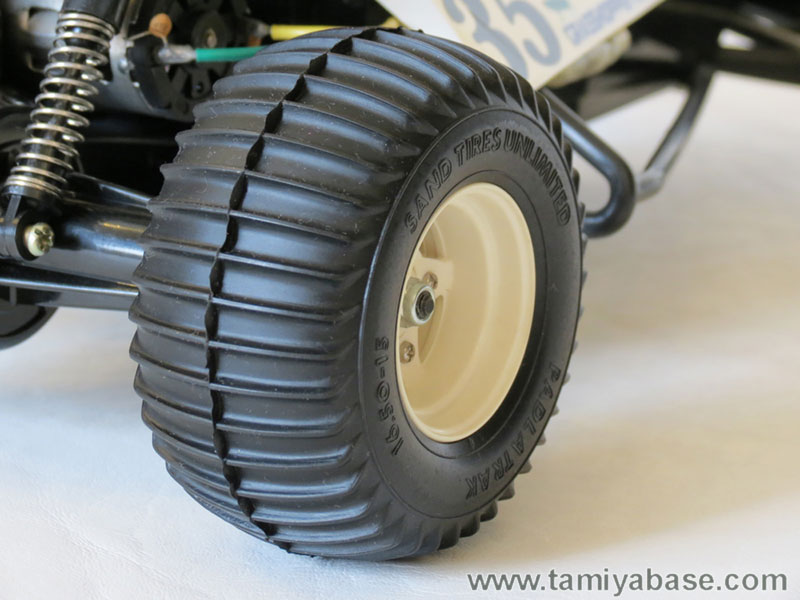
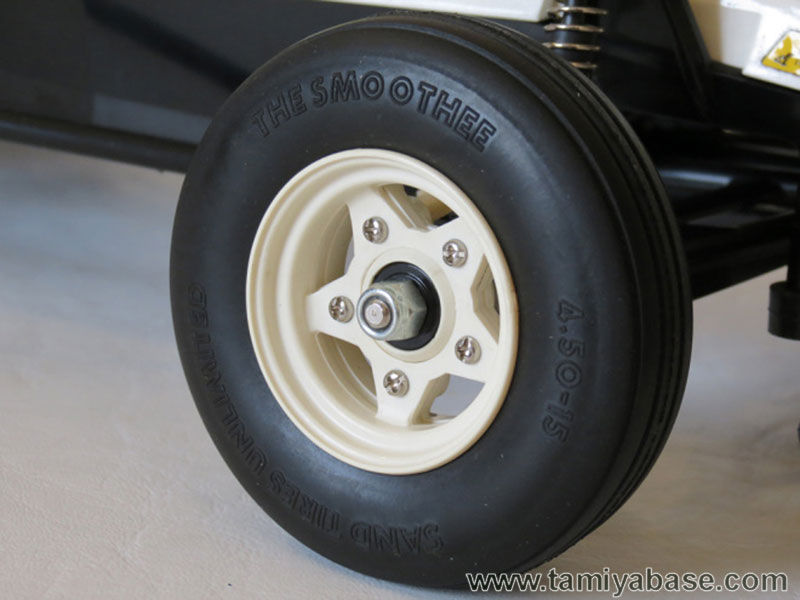
The Grasshopper features the classic Tamiya 3-piece wheels – each wheel has an inner rim, and two outer rims affixed together with tiny screw and hex nuts. It takes about 10 minutes just to assemble one wheel, but the result of this over-engineering is totally worth the effort as these are some of the prettiest wheels and tyres ever to grace an R/C model.
The tyres on the Grasshopper are identical to those used on the famous Tamiya Sand Scorcher off road beetle – “The Smoothie” tyres on the front, and “Padlatrak” paddle tyres at the rear. Incidentally, these are also real tyre types that exist in full scale for real off road cars.
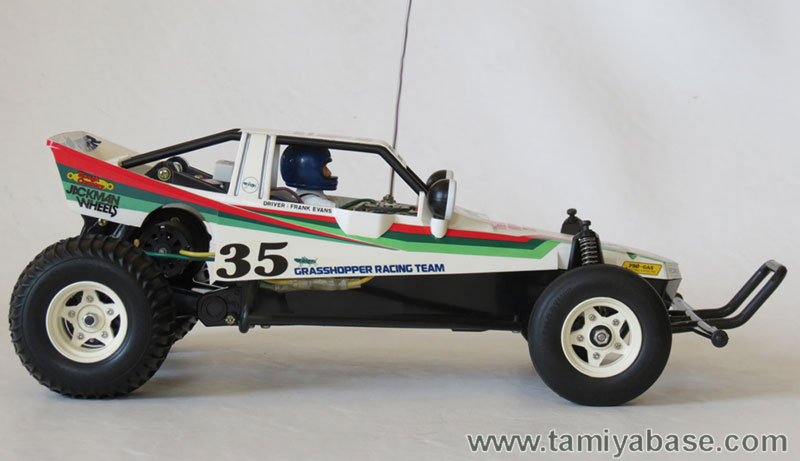
2005 Grasshopper Reissue
In 2005, the Grasshopper kit was reissued by Tamiya with (as always) a number of changes. The reissue kit itself does not have blister-packaging inside, and the box artwork has been changed to remove all the real sponsor images, as well as other small changes. The car itself features changes to the chassis and gearbox casing, and comes with an electronic speed control instead of the original mechanical speed control. It also has fake sponsor brand decals.
Here’s an image showing the chassis changes…
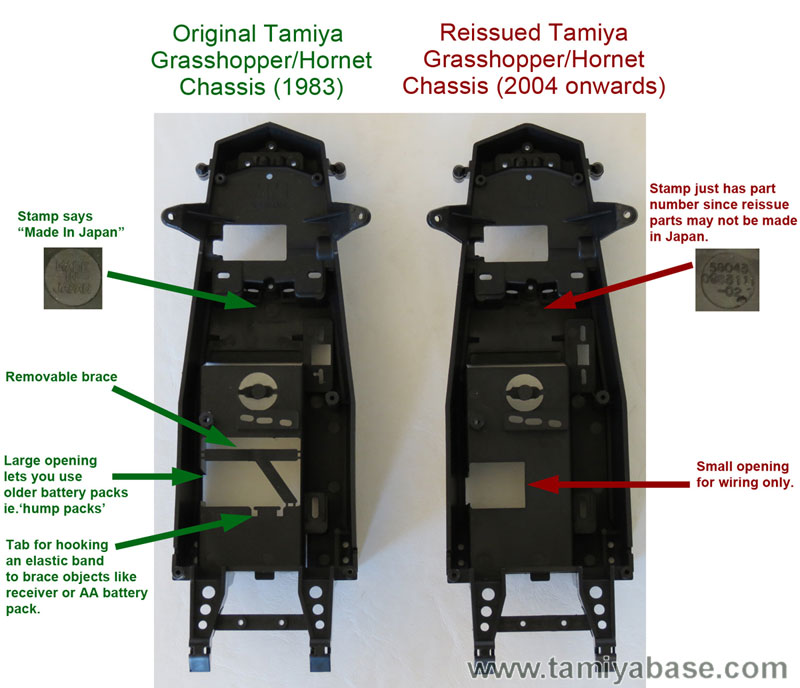
As always with reissues, they offer a cheap way to relive the model. At the time of writing, the flood of reissued kits means prices are so low that some places are selling them for as little as $100. Meanwhile, an example of the genuine original 1980s kit will be somewhere around the $500 mark if you can find one. Even an original body set alone is worth about ~$100.
The original release will always be the one that nostalgia buffs want, and it includes all the 1980s charms of genuine sponsor logos, box art, parts and electronics methods. If you can’t find or afford a brand new original kit, then there’s also a lot of fun to be had in picking up a used original, and cleaning it up (and buying just those genuine vintage parts you need). If you don’t mind tinkering, a decent used original Grasshopper can often be found for $100-$200.
An essential buggy for collectors of vintage R/C, the Grasshopper holds the distinction of being both many people’s first foray into kit-based R/C fun in the 1980s, and quite an influential car in the sense that it’s basic design proved so robust that it was reworked and copied so many times, both by Tamiya and by other R/C makers.
And let’s not forget that the popular “Taiyo Jet Hopper” even took it’s “Hopper” naming, after this car. (It seems the Grasshopper was so popular, that the very term “Hopper” was considered good marketing by Taiyo when they conceived of the Jet Hopper in 1986).
The humble Grasshopper may have been the minnow of Tamiya’s R/C lineup in terms of straight-line speed, from 1984 until it was discontinued in the late 1980s. But it’s a beautiful hard-bodied scale model buggy that is now one of the all-time legends in Tamiya’s history. I tend to think of the Frog, Hornet and Grasshopper as being the most essential cornerstone trio of all vintage Tamiya buggies, as they truly were the cars that made the brand so ubiquitous in R/C. And they were certainly the first Tamiyas I can remember wanting as a kid, as I wore out the pages of my old catalogues by flipping through them constantly, comparing and contrasting the features.
Happy collecting!
________________________
Article written by TB member Hibernaculum and originally published at www.rctoymemories.com
